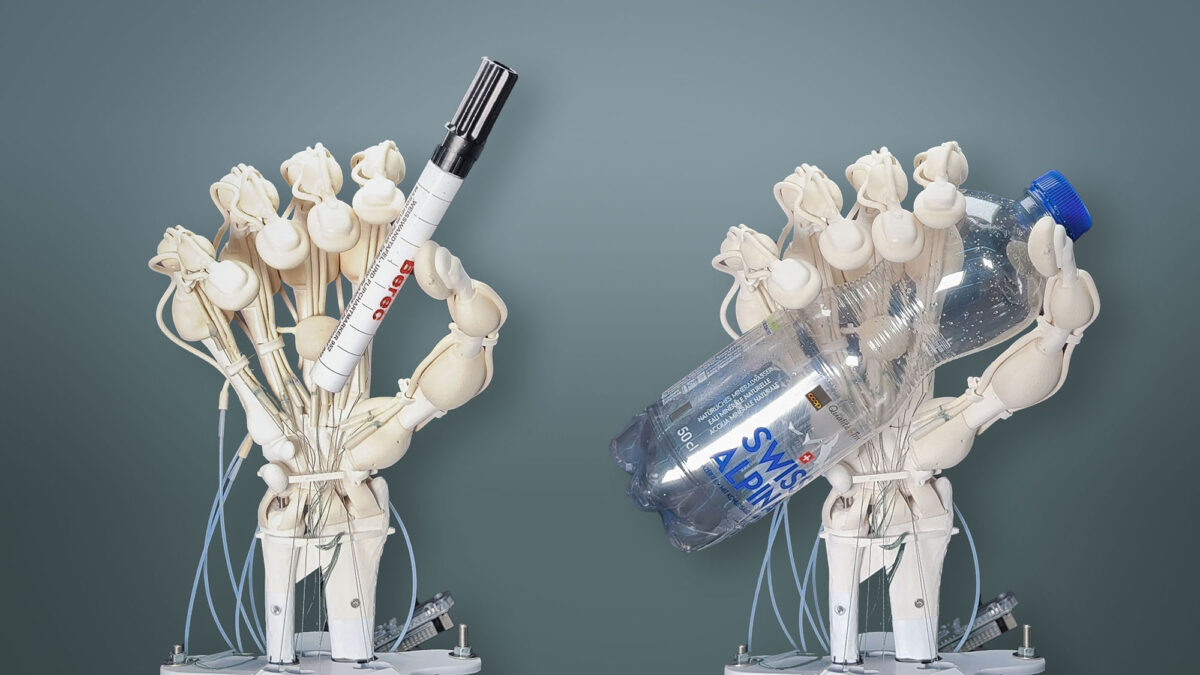Swiss Researchers and MIT Spin-off Develop Way to 3D Print Slow-curing Polymers

Using Inkbit’s technology, the team printed a robotic hand with bones, ligaments and tendons made of different polymers
Working with a U.S. startup, researchers in Switzerland have, for the first time, found a way to 3D print slow-curing polymers. This, they say, enables them to produce complex, more durable robots from a variety of high-quality materials in a single print, without assembly of subcomponents. They have used the technology to 3D print a robotic hand with bones, ligaments and tendons made of different polymers using a new laser scanning technique.
Medford, Mass.-based Inkbit, an Massachusetts Institute of Technology (MIT) spin-off, developed the new printing technology, called Vision-Controlled Jetting (VCJ). They collaborated on the project with researchers at ETH Zürich, a Swiss public research university. The Swiss team developed several robotic applications and helped optimize the printing technology for use with slow-curing polymers.

Inkbit CEO Davide Marini. Courtesy of Inkbit
The new process is said to make it easy to combine soft, elastic, and rigid materials. The researchers said they also can use it to create delicate structures and parts with cavities as desired. The two groups have now teamed up to jointly publish details about their technology and the sample applications in the journal Nature.
Inkbit CEO Davide Marini says the practical applications of this technology are vast. “VCJ not only enhances the resolution and functional capabilities of printed components. It also enables fabrication of intricate internal networks of channels and cavities to carry signals, power or fluids through the structure. With VCJ, it is now possible to directly fabricate sophisticated, multi-functional systems capable of performing complex physical tasks at scale.”
Using slow-curing thiolene polymers

ETH Zürich’s Thomas Buchner. Courtesy of ETH Zürich
“We wouldn’t have been able to make this hand with the fast-curing polyacrylates we’ve been using in 3D printing so far,” explains Thomas Buchner, a doctoral student in the group of ETH Zürich robotics professor Robert Katzschmann and first author of the study. “We’re now using slow-curing thiolene polymers. These have very good elastic properties and return to their original state much faster after bending than polyacrylates.”
This makes thiolene polymers ideal for producing the elastic ligaments of the robotic hand. Additionally, the stiffness of thiolenes can be fine-tuned to meet the requirements of soft robots.
Katzschmann said: “Robots made of soft materials, such as the hand we developed, have advantages over conventional robots made of metal. Because they’re soft, there is less risk of injury when they work with humans, and they are better suited to handling fragile goods.”
Dealing with surface irregularities

ETH Zürich’s Robert Katzschmann. Courtesy of ETH Zürich
3D printers typically produce objects layer by layer, with nozzles depositing a given material in viscous form at each point. A UV lamp then cures each layer immediately. Previous methods involved a device that scraped off surface irregularities after each curing step. This works only with fast-curing polyacrylates, since slow-curing polymers such as thiolenes and epoxies would gum up the scraper.
To accommodate the use of slow-curing polymers, the researchers added a 3D laser scanner that immediately checks each printed layer for any surface irregularities. This means that instead of smoothing out uneven layers, the new technology simply takes the unevenness into account when printing the next layer.
“A feedback mechanism compensates for these irregularities when printing the next layer by calculating any necessary adjustments to the amount of material to be printed in real time and with pinpoint accuracy,” noted Wojciech Matusik, a professor at MIT and co-author of the study. (See a video of Inkbit’s technology.)
At ETH Zürich, Katzschmann said his group will use the technology to explore further possibilities and to design even more sophisticated structures and develop additional applications. Inkbit, meanwhile, plans to use the new technology to offer a 3D printing service to its customers and to sell the new printers.
